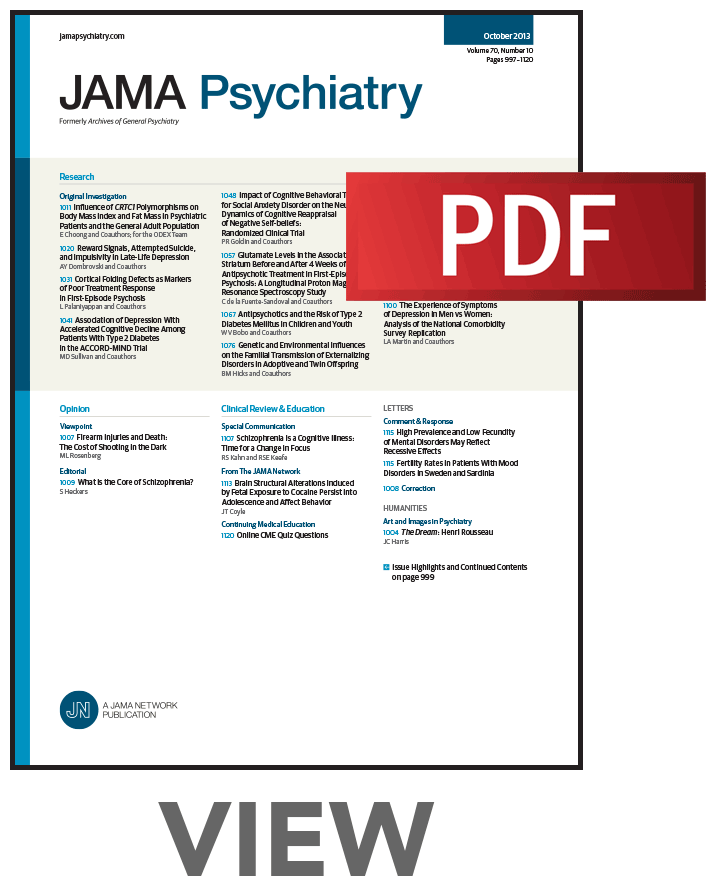精神分裂症患者皮层3层树突状脊柱缺损的区域特异性。
IF 17.1
1区 医学
Q1 PSYCHIATRY
引用次数: 0
摘要
精神分裂症(SZ)以视觉空间工作记忆缺陷为特征,该功能依赖于包括初级视觉(V1)、后顶叶(PPC)和背外侧前额叶(DLPFC)皮质节点的分布式皮质网络。这些区域之间的连接涉及到第3层锥体神经元树突棘上的兴奋性突触。目的评估SZ是否与L3脊柱改变的大小和性质的区域差异有关。设计、环境和参与者本病例对照研究检查了20名SZ患者和20名匹配的未受影响的对照(UC)患者的脑组织,这些脑组织由阿勒格尼县法医办公室(宾夕法尼亚州匹兹堡)获得。用荧光phalloidin(用于F-actin)标记树突棘,用嗜棘蛋白免疫标记树突棘,并用共聚焦显微镜成像。暴露与精神分裂症主要结果和测量主要结果是各组间L3树突棘密度和大小在V1, PPC和DLPFC的差异。次要结果包括phalloidin和spinophilin的脊柱荧光强度。结果共纳入40例,其中20例男性14例(70%),女性6例(30%),平均[SD]年龄47.7[9.6]岁;20例男性14例(70%),女性6例(30%),平均[SD]年龄45.6[9.5]岁。SZ患者的树突棘密度降低因脊柱大小而异,V1区小棘密度较低(-18%;95% CI, -31%至-5%;P =。009), PPC中棘(-16%;95% CI, -28%至-4%;P =。01)和DLPFC (-13%; 95% CI, -21%至-4%;P =。009),大脊柱在PPC (-38%; 95% CI, -58%至-17%;P <。001)和DLPFC(-30%; 95%可信区间,-50%到-11%;P = 04)。Phalloidin荧光在小范围内较低(-9.5%;95% CI, -17% ~ -1%; P =。04)和中(-9.8%;95% CI, -18%至-1%;P =。04) V1棘和更高的大DLPFC棘(9.5%;95% CI, 0.4%至19%;P = 0.049)。在所有脊柱大小和区域,亲棘蛋白荧光较低(范围从-13%;95% CI, -24%至-2%,至-34%;95% CI, -46%至-21%;P值范围为。02至<.001)。结论及相关性:SZ的树突棘密度因诊断和皮质区域不同而不同。由于树突棘的大小与突触稳定性(大/中棘)和可塑性(小棘)有关,SZ受累棘大小的区域差异可能反映了皮层视觉空间工作记忆网络的初级感觉和关联区域的不同功能障碍。本文章由计算机程序翻译,如有差异,请以英文原文为准。
Regional Specificity of Cortical Layer 3 Dendritic Spine Deficits in Schizophrenia.
Importance
Schizophrenia (SZ) is characterized by deficits in visual-spatial working memory, a function dependent on a distributed cortical network that includes nodes in the primary visual (V1), posterior parietal (PPC), and dorsolateral prefrontal (DLPFC) cortices. The connections across these regions involve excitatory synapses on the dendritic spines of pyramidal neurons in layer 3 (L3).
Objective
To assess whether SZ is associated with regional differences in the magnitude or nature of L3 spine alterations.
Design, Setting, and Participants
This case-control study examined brain tissue from 20 individuals with SZ and 20 matched unaffected comparison (UC) individuals, obtained by the Allegheny County Office of the Medical Examiner (Pittsburgh, Pennsylvania). Dendritic spines were labeled using fluorescent phalloidin (for F-actin) and immunolabeling for spinophilin and imaged by confocal microscopy.
Exposure
Schizophrenia.
Main Outcomes and Measures
Primary outcomes were between-group differences in L3 dendritic spine density and size across V1, PPC, and DLPFC. Secondary outcomes included spine fluorescence intensities of phalloidin and spinophilin.
Results
Forty individuals were studied (20 UC: 14 [70%] male and 6 [30%] female; mean [SD] age, 47.7 [9.6] years; 20 SZ: 14 [70%] male and 6 [30%] female; mean [SD] age, 45.6 [9.5] years). Dendritic spine density reductions in individuals with SZ varied by spine size across regions, with lower densities of small spines in V1 (-18%; 95% CI, -31% to -5%; P = .009), medium spines in PPC (-16%; 95% CI, -28% to -4%; P = .01) and DLPFC (-13%; 95% CI, -21% to -4%; P = .009), and large spines in PPC (-38%; 95% CI, -58% to -17%; P < .001) and DLPFC (-30%; 95% CI, -50% to -11%; P = .004). Phalloidin fluorescence was lower in small (-9.5%; 95% CI, -17% to -1%; P = .04) and medium (-9.8%; 95% CI, -18% to -1%; P = .04) V1 spines and higher in large DLPFC spines (9.5%; 95% CI, 0.4% to 19%; P = .049). Spinophilin fluorescence was lower across all spine sizes and regions (a range from -13%; 95% CI, -24% to -2%, to -34%; 95% CI, -46% to -21%; P values ranging .02 to <.001).
Conclusions and Relevance
L3 dendritic spine density differs by diagnosis and cortical region in SZ. Because dendritic spine size is associated with synaptic stability (large/medium spines) and plasticity (small spines), regional differences in the sizes of affected spines in SZ may reflect differing functional impairments in the primary sensory and association regions of the cortical visual-spatial working memory network.
求助全文
通过发布文献求助,成功后即可免费获取论文全文。
去求助
来源期刊

JAMA Psychiatry
PSYCHIATRY-
CiteScore
30.60
自引率
1.90%
发文量
233
期刊介绍:
JAMA Psychiatry is a global, peer-reviewed journal catering to clinicians, scholars, and research scientists in psychiatry, mental health, behavioral science, and related fields. The Archives of Neurology & Psychiatry originated in 1919, splitting into two journals in 1959: Archives of Neurology and Archives of General Psychiatry. In 2013, these evolved into JAMA Neurology and JAMA Psychiatry, respectively. JAMA Psychiatry is affiliated with the JAMA Network, a group of peer-reviewed medical and specialty publications.
 求助内容:
求助内容: 应助结果提醒方式:
应助结果提醒方式:


